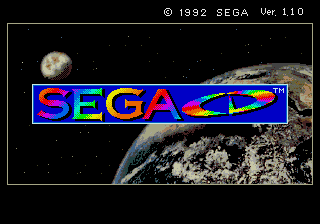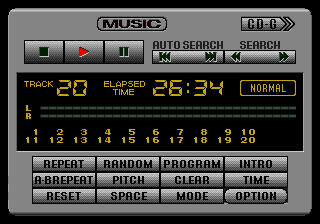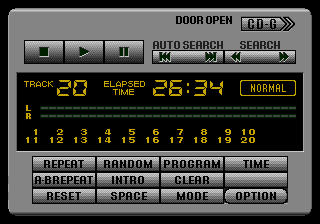Sega CD
| Sega CD |
|---|
|
Also known as: Mega-CD (JP regular), Wondermega (JP Victor), X'Eye (US JVC), Sega Mega-CD (EU/AU), CD Aladdin Boy (KR)
|
The Sega CD was Sega's answer to the PC-Engine CD in Japan. It had fairly decent third-party support and a strong launch showing in Japan (where the Mega Drive was never in first place)... but between the Super Famicom's popularity in Japan, and Sega of America and Sega Europe's insistence on shoving out FMV games, that success just could not last anywhere. In fact, all those FMV games are what it's mostly remembered for now.
Contents
Version Differences
Variant Sega/Mega-CD systems include:
- Sega CD (US)/Mega-CD (Japan, Asia, Europe/Australia) [1991] - The original add-on model for separate Genesis/Mega Drive and Genesis 2 consoles.
- Wondermega (JP) [1992] - An all-in-one Mega Drive and Mega-CD, usually with other extra features. Both Sega and Victor marketed Wondermega models.
- Sega CD 2 (US)/Mega-CD 2 (Japan, Europe/Australia) [1993] - A cost-reduced add-on model for separate Genesis and Genesis 2 consoles, with a totally revised form factor.
- Sega PAC (Japan, US) [1993] - One of several add-on modules for Pioneer's LaserActive LaserDisc player (others include the NEC PAC for the PC Engine family). Allows the system to play not only Genesis and Sega CD games, but also the exclusive "LaserActive Mega LD" format: essentially, a LaserDisc with a similar game program to a Sega CD (these games constitute their own separate platform with a separate software library).
- Wondermega M2 (JP)/X'eye (US) [1993] - An all-in-one Genesis and Sega CD, usually with other extra features. A revised model of the original Wondermega, this time marketed just by Victor. The M2 version was the basis for the X'Eye, marketed in the US by Victor's parent company, JVC.
- CDX (US)/Multi-Mega (EU/AU)/Linguaphone Education Gear (JP) [1994] - An all-in-one Genesis, Sega CD, and portable CD player.
- Aiwa CSD-GM1 (Japan) [1994] - A rare Aiwa portable stereo with a Mega Drive and Mega-CD integrated.
BIOS Versions
| To do: See if any of these BIOSes will just load arbitrary code (not check the game region). |
There are many, many, many different versions of the Sega CD BIOS, each featuring their own boot screens and UIs, and each running on a different set of Mega Drives.
Bios versions greater than 2.00 can use the Sega Mega Mouse for the controlling of menus.
Note: The Intro Type and UI Type numbering is arbitrary and provided for expository purposes only. They do not represent any sort of official classification or order.
| System | Region | BIOS Ver. | Timestamp | Will the system run if connected to a Mega Drive that comes from... | Intro Type | UI Type | MMM Type | |||
|---|---|---|---|---|---|---|---|---|---|---|
| ...Japan? | ...Asia? | ...the US? | ...Europe? | |||||||
| Mega-CD (model 1) | Japan | 1.00g | 11/20-1991 17:00 | Yes | Yes | Yes | Yes | 1 | 1 | 1 |
| Mega-CD (model 1) | Japan | 1.00l | 12/02-1991 15:20 | Yes | Yes | Yes | Yes | 1 | 1 | 1 |
| Mega-CD (model 1) | Japan | 1.00o | 12/06-1991 10:10 | Yes | No | No | No | 1 | 1 | 1 |
| Mega-CD (model 1) | Japan | 1.00p | 12/17-1991 12:00 | Yes | No | No | No | 1 | 1 | 1 |
| Mega-CD (model 1) | Japan | 1.00S | 12/28-1991 18:30 | Yes | No | No | No | 1 | 1 | 1 |
| Mega-CD (model 1) | Asia | 1.00S | 12/28-1991 20:30 | Yes | Yes | No | Yes | 1 | 1 | 1 |
| Sega CD (model 1) | US | 1.00 | 08/04-1992 03:00 | No | No | Yes | No | 2 | 2 | 1 |
| Sega CD (model 1) | US | 1.10 | 10/11-1992 18:30 | No | No | Yes | No | 2 | 2 | 1 |
| Mega-CD (model 1) | Europe | 1.00 | 10/27-1992 15:15 | No | No | No | Yes | 3 | 1 | 1 |
| Wondermega (Victor) | Japan | ? | ? | Yes | ? | ? | ? | 7-A | 1 | 3 |
| Wondermega (Sega) | Japan | 1.00W | 02/06-1992 01:30 | Yes | No | No | No | 7-A | 1 | 3 |
| Mega-CD 2 | Japan | 2.00c | 12/22-1992 14:00 | Yes | Yes | Yes | Yes | 4 | 1 | 2 |
| Sega CD 2 | US | 2.00 | 03/14-1993 01:00 | No | No | Yes | No | 5 | 3 | 2 |
| Mega-CD 2 | Europe | 2.00 | 03/30-1993 12:00 | No | No | No | Yes | 6 | 3 | 2 |
| Sega CD 2 | US | 2.00W | 06/01-1993 20:00 | No | No | Yes | No | 5 | 3 | 2 |
| Mega-CD 2 | Europe | 2.00W | 06/01-1993 20:00 | No | No | No | Yes | 6 | 3 | 2 |
| Sega CD 2 | US | 2.11X | 06/21-1993 16:00 | No | No | Yes | No | 5 | 3 | 2 |
| Sega PAC for LaserActive | Japan | 0.98 | 03/29-1993 17:00 | Yes | No | No | No | 9 | Inaccessible | Inaccessible |
| Sega PAC for LaserActive | US | 0.98 | 03/29-1993 17:00 | No | No | Yes | No | 9 | Inaccessible | Inaccessible |
| Sega PAC for LaserActive | US | 1.04 | 09/22-1993 17:00 | No | No | Yes | No | 9 | Inaccessible | Inaccessible |
| Sega PAC for LaserActive | Japan | 1.05 | 10/07-1993 11:00 | Yes | No | No | No | 9 | Inaccessible | Inaccessible |
| Wondermega M2 | Japan | 2.00 | 05/27-1993 13:20 | Yes | No | No | No | 7-B | 4-A | 4 |
| X'Eye | US | 2.00 | 12/27-1993 16:30 | Yes | Yes | Yes | Yes | 8 | 4-B | 4 |
| Aiwa CSD-GM1 | Japan | 2.11c | 05/28-1993 14:00 | Yes | Yes | No | No | 4 | 1 | 2 |
| CDX | US | 2.21X | 09/07-1993 19:00 | No | No | Yes | No | 5 | 3 | 5 |
| Multi-Mega | Europe | 2.21X | 09/16-1993 14:00 | No | No | No | Yes | 6 | 3 | 5 |
| Linguaphone Education Gear | Japan | ? | ? | Yes | No | No | No | 6 | 3 | Unknown |
Intro Types
To do:
|
Note: Different BIOS builds and/or different hardware may feature minor variations on what is otherwise the same intro type, such as changes to version numbering, copyright or labeling changes (e.g. Intro Types 7-A and 7-B).
| Intro Type | Screenshot | BIOS Music | Notes | ||||
|---|---|---|---|---|---|---|---|
| 1 | 
|
01 |
Depicts the Japanese Mega-CD logo animated against a sky backdrop. A replica of this boot screen, complete with music, also appears as a gag in Panic! as scene 12-D. (Footage) The US localization of that game does not change the scene at all, even though no American Sega CD model features this boot screen. | ||||
| 2 | 
|
02 |
Depicts the Sega CD and SEGA logos animated against a space backdrop. Neither the first part of the animation, nor the first part of the background music, loop. | ||||
| 3 | 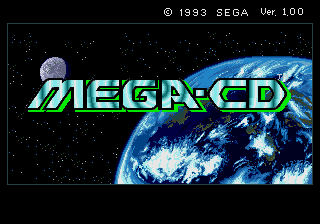
|
01 |
Depicts the European Mega-CD Logo and the SEGA logo animated against a space backdrop, similar (but not identical) to Intro Type 2. | ||||
| 4 | 
|
01 |
Depicts the Japanese Mega-CD 2 logo (the only region with a Mega-CD 2 logo) and the SEGA logo, animated against a backdrop which features some geometric solids and Sonic striking one of his trademark poses. Among the animations are some that move the logos through the layer behind the shapes. | ||||
| 5 | 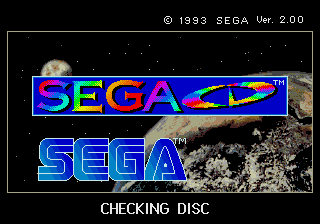
|
03 |
Depicts the Sega CD and SEGA logos animated against the same space backdrop from Intro Type 2. The animations are nearly (if not exactly) identical to those in Intro Type 4, but since the backdrop is different, they may look odd at times. | ||||
| 6 | 
|
01 |
Depicts the European Mega-CD logo and the SEGA logo animated against a similar backdrop to Type 4's, the biggest change being the replacement of Sonic with a yellow CD. Unlike Type 4, Type 6's animations keep the logos permanently layered on top of everything in the backdrop and no longer pass them behind the shapes. Otherwise, the animations are nearly (if not entirely) identical to the other versions. | ||||
| 7-A | 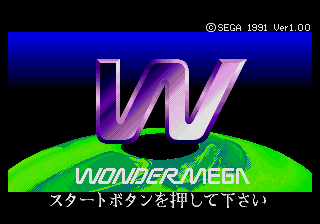
|
01 |
The first of the Wondermega "Type 7" variants. Depicts a static Wondermega logo and an animated "W" logo against a spherical torus backdrop (from the Victor model's box art) whose colors cycle through the rainbow. The two Type 7 intros are identical except for their instruction captions and copyright information. In Type 7-A, they read as follows:
| ||||
| 7-B | 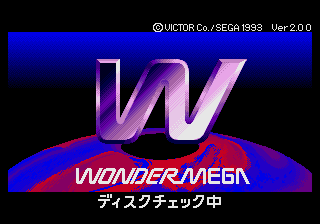
|
01 |
The second "Type 7" variant. identical to Type 7-A in every way, except for the instruction caption and copyright information having been revised as follows:
While the BIOS builds used by the Wondermega and Wondermega M2 both use very similar Type 7 variant boot screens, they use entirely different UIs from each other. | ||||
| 8 | 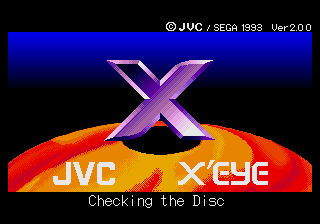
|
01 |
Another variant of Intro Type 7, virtually identical to the others apart from a) the obvious replacement of all the Wondermega branding with JVC and X'Eye branding, and b) the removal of a few animations. The X'Eye's BIOS otherwise shares its UI with the Wondermega M2. | ||||
| 9 | 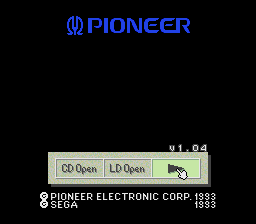
|
N/A |
The Sega PAC uses a barebones menu with Pioneer branding and copyright information. The screen has some animation: a large LaserActive logo zooming into the screen and stopping once it gets close, accompanied with a little descending whoosh sound. This screen is unresponsive in emulators or actual Mega/Sega CD systems, possibly due to differences between the respective hardware of the Sega PAC and conventional Mega-CD systems. |
UI Types
Note: Different BIOS builds and/or different hardware may feature minor variations on what is otherwise the same UI type, such as minor design or labelling changes.
Memory Management Menu
To do:
|
Boot ROMs intended for different models of Sega CD hardware, appropriately enough, change the console's icon in the save data management menu to match their model.
Note: The language used on this screen is either English or Japanese depending on the region of the BIOS, but the icons remain the same regardless of region.
| UI Type | Screenshot | Notes |
|---|---|---|
| 1 | 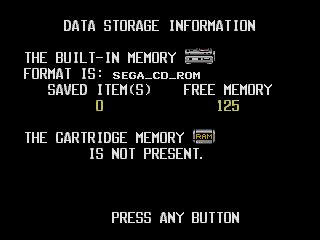
|
Used on Model 1 systems.
|
| 2 | 
|
Used on Model 2 systems and the Aiwa CSD-GM1.
(Source: AERGAN])
|
| 3 | 
|
|
| 4 | 
|
|
| 5 | 
|
Used on the CDX all in one console. |
Region Lockout
Some Sega CD Boot ROMs have checks in place to prevent you from mixing and matching different region Sega CDs and Geneses (Genesi?). If the Boot ROM with region locking detects a region mismatch at boot, then it will display a message in black text on a light blue background. This message changes depending on which region of Sega CD you have.
| Japan | US | Europe |
|---|---|---|
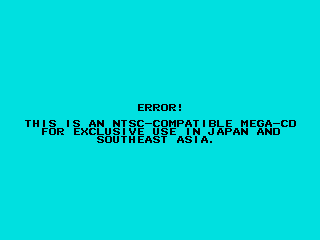
|

|

|
Interestingly enough some Boot ROMs that don't region lock consoles (such as the JVC X'Eye's Boot ROM) have the message for the lock out still inside the ROM viewable through a hex editor.
Early Boot ROMs such as 1.00g seem to be the exception
- Pages missing developer references
- Games developed by Sega
- Pages missing publisher references
- Games published by Sega
- Games published by Victor
- Games published by JVC
- Games published by Tec Toy
- Games published by Samsung
- Pages missing date references
- Games released in 1991
- Games released in December
- Games released on December 12
- Games released in 1993
- Games released in March
- Games with regional differences
- Games with revisional differences
- To do
- Sega CD games
- BIOS/Firmware ROMs
Cleanup > Pages missing date references
Cleanup > Pages missing developer references
Cleanup > Pages missing publisher references
Cleanup > To do
Games > BIOS/Firmware ROMs
Games > Games by content > Games with regional differences
Games > Games by content > Games with revisional differences
Games > Games by developer > Games developed by Sega
Games > Games by platform > Genesis games > Sega CD games
Games > Games by publisher > Games published by JVC
Games > Games by publisher > Games published by JVC > Games published by Victor
Games > Games by publisher > Games published by Samsung
Games > Games by publisher > Games published by Sega
Games > Games by publisher > Games published by Tec Toy
Games > Games by release date > Games released in 1991
Games > Games by release date > Games released in 1993
Games > Games by release date > Games released in December
Games > Games by release date > Games released in December > Games released on December 12
Games > Games by release date > Games released in March
